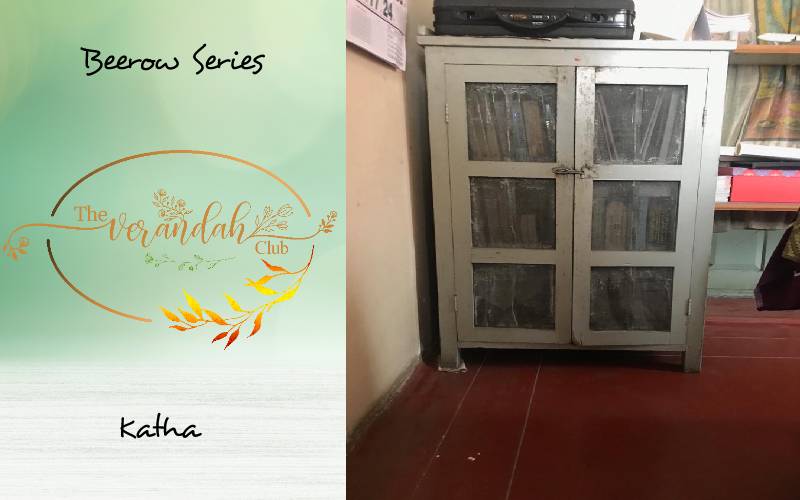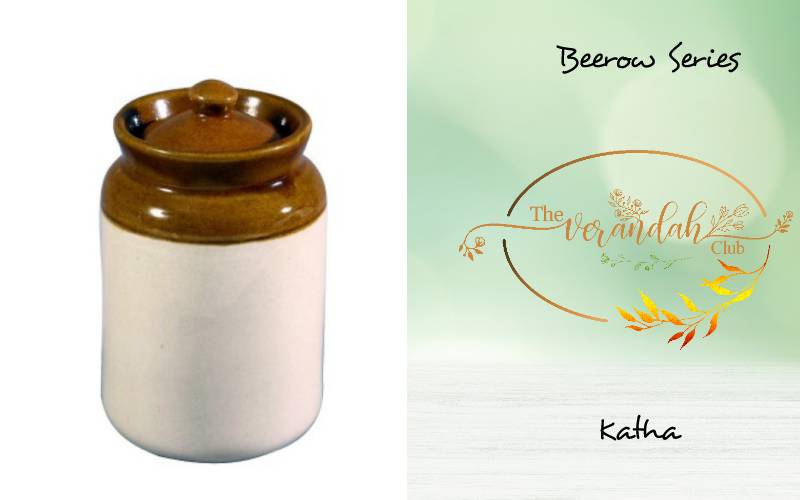
‘What’s in my beerow?’
The wafting aroma of the vattal kuzhambu stirred me. I thought it was yet another day at home when Amma decided to handle the mantle of cooking. Oh… but wait…how was that possible? That’s my job and I was dreaming… Lost in my thoughts, some new voices forced me to open my eyes. “Enna de Kaamu, paal karundhutiya?’, asked a sweet yet authoritative female voice, while tapping the karandi on the kalchatti containing the kuzhambu. “Yenga Rukku manni… adhukkulla oru chinna velai. Amma va thedinen… koil poirukkalaamey. Manni… konjam saavi tharela,” said a docile 30-year-old Kaamu in a hesitant voice.
This was not my kitchen. I saw two madisaar-clad ladies in an age-old kitchen lit by a window. Walls covered with kari marks left behind by the seasoned stove, traditional mann chatti, and other age-old cooking vessels. This was 1940s. A time travel….? The voices brought me back to the reality. “Indhaa saavi. Aana bathiram. Velai mudinjadhum saavi en kitta varanum. Apparam Mami (mamiyaar) tholachuduvaa,” said a slightly agitated middle-aged Rukku.
“Seri Manni. Naan parthukkaren,” said Kaamu. Carefully securing the saavi in the folds of her madisaar, Kaamu started leaving the kitchen. What was this suspense all about? I slowly came out of my hiding place behind the water pitcher. Despite throwing a glance at me, Kaamu hurried across the house to a deserted room. Phew, I was invisible to them. I stealthily followed quick-paced Kaamu. The room contained kitchen grocery, arisi paanai and a valai beerow. Was all this secrecy about the beerow? She slowly tiptoed to the beerow, looked around her to check if she was alone. Then, she opened the beerow and I saw the treasure that she was safeguarding. Two large uppu jaadis containing pickles. Voila, maanga oorga vaasanai mooka tholaikkaradhu…
Mention the word ‘homemade pickles’, I am sure any elder from the family would agree that it was indeed a treasure. Be it at home or even in the famous temple in Srirangam, a pickle room was considered celestial with the ever-present “No admission’ sign on it. The reason? Pickle is believed to be the representation of Goddess Lakshmi’s palm (Lakshmi karam). The house that has pickles is believed to be blessed with wealth and prosperity.
Also, the whole process of pickling was more than a mere task. A ritual that is supposed to be hygienic (no loose hair), pious (participating in pickling during menstruation was a big no-no. Also, onion and garlic pickles were kept away from the beerow.), meticulous, disciplined and above all, strict (keeping the room closely guarded).
Fond memories
“It all began with mentally preparing oneself for the season. Also, this meant discussing which lucky pickles would make it to the beerow this year,” recalls 67-year-old Shantha. M, with a twinkle in her eyes. Other than mangoes and lime, other vegetable like kalaakkai, chikkidikkai were very exotic varieties and completely localised.
So, it begins with a careful operational research on procuring the raw materials to preparing the vessels for the process. The bigger jaadis served as the main storage vessels, while smaller ones were used for serving lesser quantities.
“My grandfather was a jeweller. He always mentioned that picking mangoes was like carefully choosing gemstones,” remembers Vasu, who was merely a ten-year old back then. He continues telling us how has observed the working of three generation of women at work. Behind closed doors, his grandmother and other ladies would be involved in the pickling process.
“It was mainly to ward off the ‘evil eye’ from hindering the pickling process,” he says.
Shantha recalls her experiences from the 1930s. “My husband’s ancestral house had two entrances to the kitchen. One of the entrances led to a special store room,” she says. The room was neatly stacked with ural and ulakku (pestle and mortar)and two veragu aduppu (firewood stove) and a valai beerow, which was a part of almost every house in that era.
“The beerow housed various pickles tucked away in jaadis of varying sizes. To prevent ants from invading the beerow, the groove at the base was filled with water,” explains Lakshmi, octogenarian, who was part of a huge joint family. There was something for all age groups.
“For example, a less spicy version of lime pickle was reserved for kids,” explains Janaki Amma, a 73-year-old seasoned homemaker from Chennai. Thus, all kinds of pickles like lime, mango and oota made to the beerow.

Delicious mangoes are ready for the summer season
Lalitha Sundarajan, a seasoned homemaker, recalls how her mother-in-law taught her the art of pickling. Her speciality was mangai oorgai. “Since my mother-in-law resided in Andhra Pradesh she was well-versed in it,” she says. So, it all began with carefully picking the vadu in a gunny sack sold by street vendors. She explains how the Thirumoorthy vadu was better than the Thadaga vadu.
This was followed by meticulously cleaning the vadu of dirt, mud, and segregating it. “That meant that vadu with milk or without a kaambu were immediately rejected,” she explains.
Soaked for two hours, it was drained using a moongil koodai (bamboo basket) or thattu koodai. The quality of ingredients like salt, long-stemmed chillies, castor oil and the layering make a huge difference to the pickle. “Using iodised salt can alter the taste of the mango pickle. So plain podi uppu is ideal,” she explains. Work began after completing the daily chores well in advance. She recalls how the summer season kept them on their toes in making pickles like avakkai, lemon and even kadaranga.
Curd for pickling
Interesting name, ‘Oota’! Lakshmi Amma goes on to tell us more about it. “It is a unique combination of mor (yoghurt) and mel podi (a spicy mix of turmeric, mustard powder and chilly powder). So, the process involved straining the wet mixture using a white pure cotton cloth.” Oota was one of the healthiest choices as a pickle created by our elders. This is because it is oil-free and rich in probiotics, thanks to the yogurt. Half of a jaadi is filled and refilled after ten days. Maavidi Kommu, Chikidi kaai and vilvakkai are soaked in oota. It is also soaked and eaten. A delicious combo with thayir saadham. If one thought that oota turned out to be too spicy, the soaked vegetables could be washed using water.
Offbeat pickle options
“Yet another interesting pickle garland is made using kalaakkai. It is slit, deseeded and filled with powder and made into a garland and suspended. “We loved plucking it and eating it with or without rice,” recalls Vasu. Talk about pickles and oorgai saadham is what comes to my mind: spicy and lip-smacking. Maavadikkai oorga was served with rice and kollu podi (horse gram powder) and a generous dose of gingelly oil to complete the taste. “A perfect dry roasted combo of urad dal and horse gram ensures the body gets the much-needed share of protein,” says young Sumitra, who learnt the art from her mother-in-law. Also, having the onion pickle with rice is also an interesting combo.
“I spent my childhood in Salem and I remember having Naravallikkai oorgai with rasam saadham,” says Vasu. Quite popular in Salem, Naravallikkai is of the size of a marble, which is stuffed with a filling.
Bringing people together
Summer time meant fun time for the women in the house. Decked up in pattu sarees adorned by diamond mookuthi (nose-pin), kammal, and bangles, they set out to buy raw materials. In many families, the domestic bought the necessary vegetables. But Vasu fondly remembers how his grandmother said that despite having any number of domestic helps at home, it was important to earn one’s bread. So, pickling was an ideal way of doing so.
“The shelf life of pickles was quite long. Let me put it this way. If a newly-wed bride learns the art of pickling, a year-and a half later, she introduces the taste of the same oorgai to her infant,” says a smiling Janaki Amma.
It was also the time when the women in a family came together for a common cause. “While picking mangoes, it began with checking out the smell of the mangoes, the volume of the heap of sharing duties and taking charge of the whole process,” recalls Shantha Amma.
Expertise brought in
Vasu fondly recalls how his family was very particular about a certain form of maanga oorgai prepared by Kerala Iyers. “My grandfather made sure that an Iyer from Palakkad was brought in for this every summer. Our work was to hand over the requisites and sit back and observe,” says Vasu.
Indeed, a treasure in many ways. So, imagine a valai beerow filled with nearly 50 odd uppu jaadis of varying sizes, which can hold good for at least a year. We are talking about investment worth a fortune. Indeed, a real boon given by Goddess Lakshmi.
Finally, I realised that the magic of the pickle season remains unfazed till date. Jaadis may have reduced in numbers or size, health issues maybe plaguing many of us, but pickle still remains the uncrowned partner in crime of thayir sadham!
Janani Rajeswari is a freelance journalist who feels writing is a way of staying happy and positive. She teaches foreign languages. She also loves music, pets, books, movies, art and craft and learning new languages.
NEXT ARTICLE